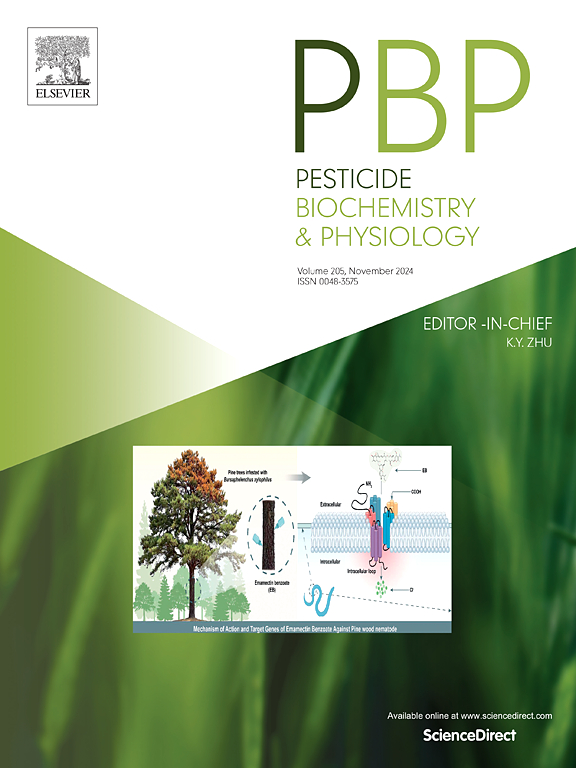磷化氢熏蒸调节背小实蝇热响应的转录及功能分析
IF 4.2
1区 农林科学
Q2 BIOCHEMISTRY & MOLECULAR BIOLOGY
引用次数: 0
摘要
东方果蝇,背小实蝇,是一种对水果、蔬菜和花卉具有高度破坏性的害虫,在国际贸易农产品中,热处理是一种常见的控制方法。然而,热处理会对质量产生不利影响,从而限制了其应用。本研究旨在建立一种磷化氢熏蒸与热处理(P + H)相结合的新型防治策略,该策略对背孢白僵菌具有显著的协同防治效果。我们进行了转录组学分析和qRT-PCR验证来探索这种协同效应。P + H显著增加了热休克蛋白(HSP)的表达,但其表达水平低于单独热处理。基于rnai的实验证实了HSP基因表达与昆虫死亡率之间的关联,进一步支持了HSP基因在热处理反应中的重要作用。功能富集分析表明,P + H处理下,MAPK/ERK信号通路和HSF-1去磷酸化动态调节HSP基因的表达。此外,细胞修复的能量分配可能进一步限制热休克蛋白基因的合成,影响昆虫对热反应的耐受性。这些发现揭示了P + H处理协同作用的分子基础,强调了HSP基因调控在昆虫抗逆性中起着关键作用,为害虫防治提供了新的途径。本文章由计算机程序翻译,如有差异,请以英文原文为准。

Transcription and functional analysis of phosphine fumigation regulating heat responses in Bactrocera dorsalis
The oriental fruit fly, Bactrocera dorsalis, is a highly destructive pest in fruits, vegetables and flowers with heat treatment being common for its control in internationally traded produce. However, heat treatment can adversely affect quality, which limits its application. This study aimed to develop a novel control strategy combining phosphine fumigation with heat treatment (P + H), demonstrating a significant synergistic effect in controlling B. dorsalis. We conducted transcriptomic analysis and qRT-PCR validation to explore this synergistic effect. P + H significantly increased the expression of heat shock proteins (HSP), but their levels were lower than those induced by heat treatment alone. RNAi-based experiments confirmed the association between HSP gene expression and insect mortality, further supporting the important role of HSP genes in response to heat treatment. Functional enrichment analysis indicated that the MAPK/ERK signaling pathway and HSF-1 dephosphorylation dynamically regulate HSP genes expression under P + H treatment. Additionally, energy allocation toward cellular repair may further limit HSP gene synthesis, affecting insect tolerance to heat response. These findings provide insights into the molecular bases for the synergism of P + H treatment, highlighting that HSP gene regulation plays as critical role in insect stress resistance and offering a novel approach to pest control.
求助全文
通过发布文献求助,成功后即可免费获取论文全文。
去求助
来源期刊
CiteScore
7.00
自引率
8.50%
发文量
238
审稿时长
4.2 months
期刊介绍:
Pesticide Biochemistry and Physiology publishes original scientific articles pertaining to the mode of action of plant protection agents such as insecticides, fungicides, herbicides, and similar compounds, including nonlethal pest control agents, biosynthesis of pheromones, hormones, and plant resistance agents. Manuscripts may include a biochemical, physiological, or molecular study for an understanding of comparative toxicology or selective toxicity of both target and nontarget organisms. Particular interest will be given to studies on the molecular biology of pest control, toxicology, and pesticide resistance.
Research Areas Emphasized Include the Biochemistry and Physiology of:
• Comparative toxicity
• Mode of action
• Pathophysiology
• Plant growth regulators
• Resistance
• Other effects of pesticides on both parasites and hosts.

 求助内容:
求助内容: 应助结果提醒方式:
应助结果提醒方式:


